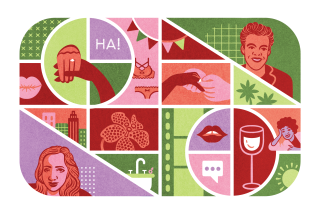‘Important Artifacts and Personal Property . . .’ by Leanne Shapton
Important Artifacts and Personal Property From the Collection of Lenore Doolan and Harold Morris, Including Books, Street Fashion, and Jewelry
Leanne Shapton
Sarah Crichton Books / Farrar, Straus & Giroux: 129 pp., $18 paper
In a 1979 New York Review of Books essay on Woody Allen, Joan Didion singles out a scene at the end of the film “Manhattan” in which Allen’s character devises a list of “reasons to stay alive”: It includes the second movement of Mozart’s “Jupiter” Symphony, Groucho Marx and “A Sentimental Education.” Didion calls the list the “ultimate consumer report” and says that the “extent to which it has been quoted approvingly suggests a new class in America, a subworld of people rigid with apprehension that they will die wearing the wrong sneaker, naming the wrong symphony, preferring ‘Madame Bovary.’ ”
Thirty years on, the tastemaker class flourishes, their passions slightly altered: The linen “cut by Calvin Klein to wrinkle” that Didion identifies as de rigueur in “the large coastal cities of the United States this summer” is now high-end denim with subtle variations in stitching and pocket placement; the “perfect vegetable terrine” now the perfectly engineered organic latte.
Leanne Shapton’s new novel takes the form of an auction catalog filled with the personal effects of Lenore Doolan and Harold Morris, members of the latest breed of New York sophisticates. They meet at a Halloween party in 2002 and quickly fall for each other. Their romance ends four years later, and the auction is held, presumably, because they no longer want the objects associated with the relationship. A descriptive blurb accompanies each item. One reads: “A theater playbill for ‘Dinner at Eight’ at the Vivian Beaumont Theatre. Handwriting in margins alternates between Doolan and Morris: ‘Are you crying? / No, allergies. / Crying!’ ” Another: “A fortune-cookie fortune, kept by Morris in his wallet, reading: ‘In life, it’s good not to get too comfortable.’ ” Their story is obliquely told through these captions.
Didion writes that Allen’s characters are like adolescents “acting out a yearbook fantasy of adult life.” The same could be said of Doolan and Morris. Doolan, who’s 26, writes a column for the New York Times’ food section on baking. Morris, almost 40, is a globe-trotting photographer with a taste for luxury hotels. (He’s hoping to publish a book of photographs of hotel ceilings.) He lives in Brooklyn, and she in the West Village -- for fun, they stay uptown at the St. Regis. When Doolan is sick, Morris ships her from London a box of Yorkshire tea, a cashmere scarf by Paul Smith and a silver choker from Agent Provocateur. Doolan’s pale-green travel pillow is a Frette.
As a work of literature, “Important Artifacts . . .” is empty. Viewed as a lifestyle catalog, it is convincing. The lots are photographed in black and white, in a plain style reminiscent of the photos in “The Official Preppy Handbook” from 1980.
Like that book, “Important Artifacts . . .” is a vade mecum for the ascendant class of the day, twenty- and thirtysomething urban hipsters. On the block are a framed photograph of Monica Vitti, Yves Saint Laurent tortoiseshell sunglasses and an Olivetti typewriter. Four Smythson agendas (one for each year), a copy of William Empson’s “The 7 Types of Ambiguity” and a Hermès beach towel.
“Important Artifacts . . .” reduces the definition of character to a series of consumer choices. It’s no wonder we don’t care about its protagonists.
Harlin has written for the Village Voice and Bookforum.
More to Read
The biggest entertainment stories
Get our big stories about Hollywood, film, television, music, arts, culture and more right in your inbox as soon as they publish.
You may occasionally receive promotional content from the Los Angeles Times.










